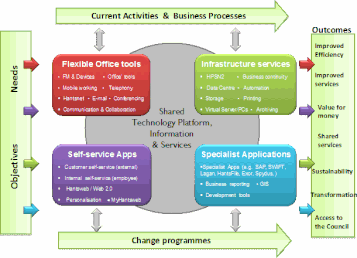Business Operating Model Design
Enterprise or Business Operating model - Is the abstract representation of how an organisation operates across process, organisation and technology domains in order to accomplish its function.
We got Strategy! What about an Operating Model and how is Operating Model different from an IT Strategy?
Strategy
We have a vision of how our leadership views the future through the delivery of value our company creates.
We have a mission that frames how our organisation will satisfy customers to realise that vision through long-term capture of value.

Business operating model
Business strategy and priorities change frequently based on external factors.
Operating model provides the foundation and flexibility required to execute the firm's initiatives.
Describes relationship between business operating units decision and process flow for the units.
Describes how an organisation operates across both business and technology domains.
Describes what is important for the organisation.
Describes how the organisation does business today.
Describes how the business co-operates across its business units.
The problem (the business perspective) if you can answer yes to any of the following questions then you needs a business operating model.
- IT does not understand business priorities.
- IT is too slow and unresponsive to new demands and requirements.
- IT projects are always behind schedule and over budget.
- IT strategy is focused on technology and not business objectives.
- The default answer is next year or simply no.
- Trend to by-pass internal IT for external options (Speed, Cost, and Control).
Reasons to have a defined Business Operating Model
- Describes relationships between business operating units, decision and process flow for the units.
- Describes how an organisation operates across both business and technology domains.
- Describes what is important for the organisation.
- Describes how the organisation does business today.
- Describes how the business co-operates across its business units.
- A solid operating model drives organization decisions (structure and roles –changing over time).
- It is the framework to achieve the vision and mission, and identify areas of accountability, competency and weakness thereby supporting improvement.
- An operating model prevents human indecisiveness that results in over-pivoting of strategy.
- It structures people’s role and responsibility in terms of declarative, consensus, consultative and autonomous decision making at the right time and place.
- It optimises productivity and time management defining who and what functions needs to attend what (type of) meeting, why and when.
We are experts in promoting integration and collaborative working. We can help you transform your operations across technology, processes and people to achieve greater results.
Testimonials

It is all about the value you bring
"Your input has made a material difference to the Public Cloud project.
Thanks again for all your work. I'm really pleased "
Liz - NHS Education for Scotland (NES)

Best decision ever
" My small business started to grow and I ran into so many overwhelming challenges and road blocks. A friend suggested a business technology partner and mentioned EITS. Best decision ever!"Stan - Cestigs
Our EcoSystem
About Us
ComputerWeekly.com
NCSC exposes Fancy Bear's Authentic Antics malware attacksAmid a new round of UK government sanctions targeting Moscow's intelligence apparatus, the NCSC has formally attributed attacks orchestrated with a cleverly-designed malware to the GRU's Fancy Bear cyber unit
>> Read More
CISPE criticised over securing preferential cloud pricing on Microsoft products for members
Microsoft has signed an agreement with cloud trade body CISPE to secure more agreeable pricing on the software giant’s cloud products for its members, much to the chagrin of the wider European cloud community
>> Read More
Useful Links
What's happening
Getting DevOps Wrong: Top 5 Mistakes Organizations Make - InformationWeek https://t.co/SgYvt45jkA @einfotechser.com
— EITS Aberdeen (@einfotechser) 12 November 2018
Connect With Us
6 Digital Transformation Mistakes To Avoid via @forbes https://t.co/iR0mCkncPk
— EITS Aberdeen (@einfotechser) 19 June 2019
Yahoo News - Latest News & Headlines
China is taking aim at American movies over Trump's tariffs. Here's why that poses a big risk to Hollywood.>> Read More
How COVID changed America, in 12 charts
>> Read More
Engadget is a web magazine with obsessive daily coverage of everything new in gadgets and consumer electronics
What the hell is going on with Subnautica 2?>> Read More
© 2021 Expertise Info-Tech Services Ltd, All rights reserved - www.btsmart.co.uk
















